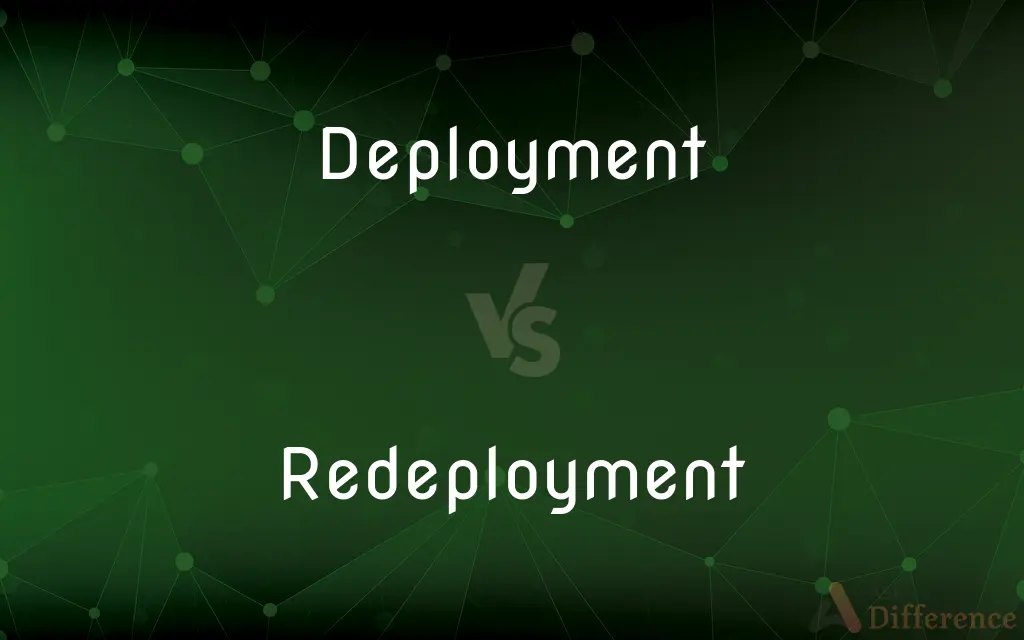Deployment vs. Redeployment — What's the Difference?
By Tayyaba Rehman & Urooj Arif — Updated on March 31, 2024
Deployment involves assigning resources or personnel for a specific purpose or operation, while redeployment refers to reassigning or reallocating them to a new task or location after their initial deployment.

Difference Between Deployment and Redeployment
Table of Contents
ADVERTISEMENT
Key Differences
Deployment is the process of moving military personnel or resources into position for action, or more broadly, assigning any resource, such as software or employees, to a specific task or function. For example, deploying troops to a conflict area or launching a new software system. Redeployment, on the other hand, involves shifting those resources or personnel from one assignment to another, often in response to changing conditions or objectives. This could mean moving soldiers to a different area of operation or assigning employees to a new project within the company.
While deployment marks the beginning of a resource’s or personnel’s assignment, redeployment signifies a transition, reflecting an adaptation to new requirements or objectives. Deploying a new technology solution in a business for the first time is a deployment, but moving that technology to serve another part of the business later on is a redeployment.
Deployment can occur without subsequent redeployment if the resources remain in their initial assignment. However, redeployment inherently depends on prior deployment, as it is a secondary action that reassigns resources already in use. This sequence highlights the dynamic nature of resource management in various contexts, including military, business, and technology.
The strategic objectives behind deployment and redeployment may differ. Deployment often aims to establish presence, capability, or influence, whether militarily, in the market, or within an organization. Redeployment, conversely, aims to optimize or realign resources in response to evolving situations or to enhance efficiency, effectiveness, or strategic positioning.
Despite their differences, both processes are crucial for effective resource management, whether in military operations, corporate strategies, or technology implementations. They require careful planning, coordination, and execution to ensure that the objectives are met, whether establishing a new presence with deployment or adapting to new challenges through redeployment.
ADVERTISEMENT
Comparison Chart
Definition
Assigning resources or personnel to a specific operation or purpose.
Reassigning or reallocating resources or personnel to a new task.
Objective
To establish presence, capability, or influence.
To optimize, realign, or respond to changing objectives or conditions.
Sequence
Initial action in the assignment of resources.
Follows deployment; a secondary action for reassignment.
Dependency
Can occur independently.
Depends on a prior deployment.
Strategic Focus
Establishing capabilities or presence.
Adapting to new requirements or enhancing efficiency.
Compare with Definitions
Deployment
Assigning software or technology to operational use.
The deployment of the new software system improved productivity.
Redeployment
Shifting military personnel or equipment to a new area of operation.
The redeployment of forces was in response to the changing conflict dynamics.
Deployment
Launching a new product or service in the market.
The deployment of the new product line met with positive consumer response.
Redeployment
Moving resources to address new challenges or opportunities.
Redeployment of capital to emerging markets showed promising returns.
Deployment
The act of moving military forces into position.
The deployment of troops to the region was seen as a strategic move.
Redeployment
Reassigning employees to different tasks or departments.
Redeployment within the company allowed for greater flexibility and efficiency.
Deployment
The distribution of resources or personnel for a specific task.
The deployment of additional staff to the project expedited its completion.
Redeployment
Reallocation of efforts towards new strategic goals.
The company's redeployment of marketing efforts significantly improved its market position.
Deployment
Initiating use or application of a resource.
The successful deployment of renewable energy technologies is crucial for sustainability.
Redeployment
Adapting technology or systems to new applications.
The redeployment of the software to support remote work was quickly implemented.
Deployment
To bring (forces or material) into action.
Redeployment
To deploy (personnel, especially military forces) to a different place or on a different assignment.
Deployment
To position (troops) in readiness for combat, as along a front or line.
Redeployment
To put to a different use or action; deploy in a different way
Redeploy the company's resources.
Deployment
To base (a weapons system) in the field.
Redeployment
To be deployed to a different area or assignment.
Deployment
To distribute (persons or forces) systematically or strategically.
Redeployment
The act of redeploying.
Deployment
To put into use or action
"Samuel Beckett's friends suspected that he was a genius, yet no one knew ... how his abilities would be deployed" (Richard Ellmann).
Redeployment
A new deployment.
Deployment
To be or become deployed.
Redeployment
The withdrawal and redistribution of forces in an attempt to use them more effectively
Deployment
An arrangement or classification of things.
Deployment
An implementation, or putting into use, of something.
Deployment
The distribution of military forces prior to battle.
Deployment
(parachuting) the start of something
Deployment
The arrangement or distribution (of resources such as people or equipment), in preparation for battle or work.
Deployment
The distribution of forces in preparation for battle or work
Common Curiosities
Why is redeployment necessary?
Redeployment is necessary to adapt to changing conditions, optimize resources, or realign strategies to meet new objectives or improve efficiency.
What is deployment?
Deployment is the process of assigning or positioning resources or personnel for a specific operational purpose or task.
Can deployment occur without redeployment?
Yes, deployment can occur without subsequent redeployment if the resources or personnel remain in their initial assignment.
What are the challenges of redeployment in a corporate setting?
Challenges of redeployment in a corporate setting include ensuring the right fit for new roles, maintaining morale, and updating training to meet the demands of new assignments.
Is redeployment common in technology?
Yes, redeployment is common in technology, where systems, software, or solutions are often reassigned or adapted to new uses or objectives.
How does redeployment benefit an organization?
Redeployment can benefit an organization by enhancing flexibility, improving resource utilization, and allowing the organization to quickly adapt to market or operational changes.
Can redeployment be temporary?
Yes, redeployment can be temporary, especially in response to short-term operational needs or project-based assignments.
What does redeployment mean?
Redeployment refers to the process of reallocating or reassigning resources or personnel to a different task, location, or purpose after their initial deployment.
How do deployment and redeployment differ in a military context?
In a military context, deployment refers to moving forces into position for action, while redeployment involves shifting those forces to a new area of operation or back home after their mission is complete.
What role does planning play in successful deployment and redeployment?
Careful planning is crucial for successful deployment and redeployment, ensuring that resources are appropriately matched to tasks, objectives are clearly defined, and potential disruptions are minimized.
Can redeployment involve risks?
Yes, redeployment involves risks such as mismatched resource capabilities, resistance to change, and potential disruptions during the transition.
What is the difference between redeployment and reassignment?
Redeployment generally refers to a broader strategic reallocation of resources, while reassignment often denotes the movement of individual employees to different roles or tasks within an organization.
How do deployment and redeployment impact employee morale?
Deployment and redeployment can impact employee morale in various ways, depending on how changes are communicated, managed, and supported within the organization.
How do businesses measure the success of redeployment?
Businesses measure the success of redeployment by evaluating improvements in efficiency, achievement of new objectives, and the overall impact on operational performance.
What is strategic redeployment?
Strategic redeployment refers to the deliberate reallocation of resources or personnel to align with long-term strategic goals or to capitalize on new opportunities.
Share Your Discovery

Previous Comparison
Trend vs. Custom
Next Comparison
Maximize vs. MaximumAuthor Spotlight
Written by
Tayyaba RehmanTayyaba Rehman is a distinguished writer, currently serving as a primary contributor to askdifference.com. As a researcher in semantics and etymology, Tayyaba's passion for the complexity of languages and their distinctions has found a perfect home on the platform. Tayyaba delves into the intricacies of language, distinguishing between commonly confused words and phrases, thereby providing clarity for readers worldwide.
Co-written by
Urooj ArifUrooj is a skilled content writer at Ask Difference, known for her exceptional ability to simplify complex topics into engaging and informative content. With a passion for research and a flair for clear, concise writing, she consistently delivers articles that resonate with our diverse audience.















































